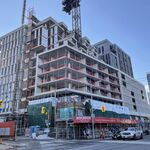Interesting perspective. It points to how dogma in transit can go terribly wrong, which is the case in Toronto given a fundamental lack of funding where in the void left by the long-gone departure of responsible, consistent, long term city planning and infrastructure investment Transit became a messy and volatile political battleground best characterized as stalemate. In the end, the gain of an inch here does little to compensate for the loss of one there, and no 'side' wins. In the meantime this transit war of inertia and words awaits nothing less than a Vimy Ridge-style assault to break its standstill.
Stalemate and politics notwithstanding, most of us without some vested or partisan interest understand that speed across distance along with local mobility are what is required over time to make a truly sustainable form of public transit. This means a framework of subways fed by a network of LRT. Simplistic, yes, but is this really all that different from what we see in other cities of Toronto's scale that we would want to emulate?





